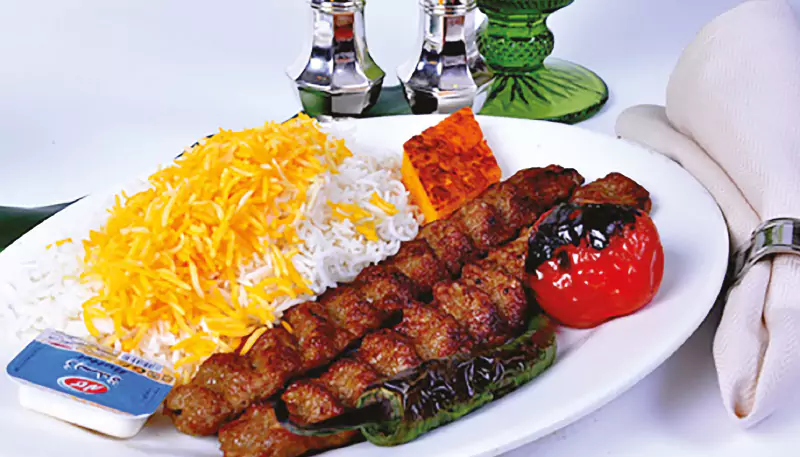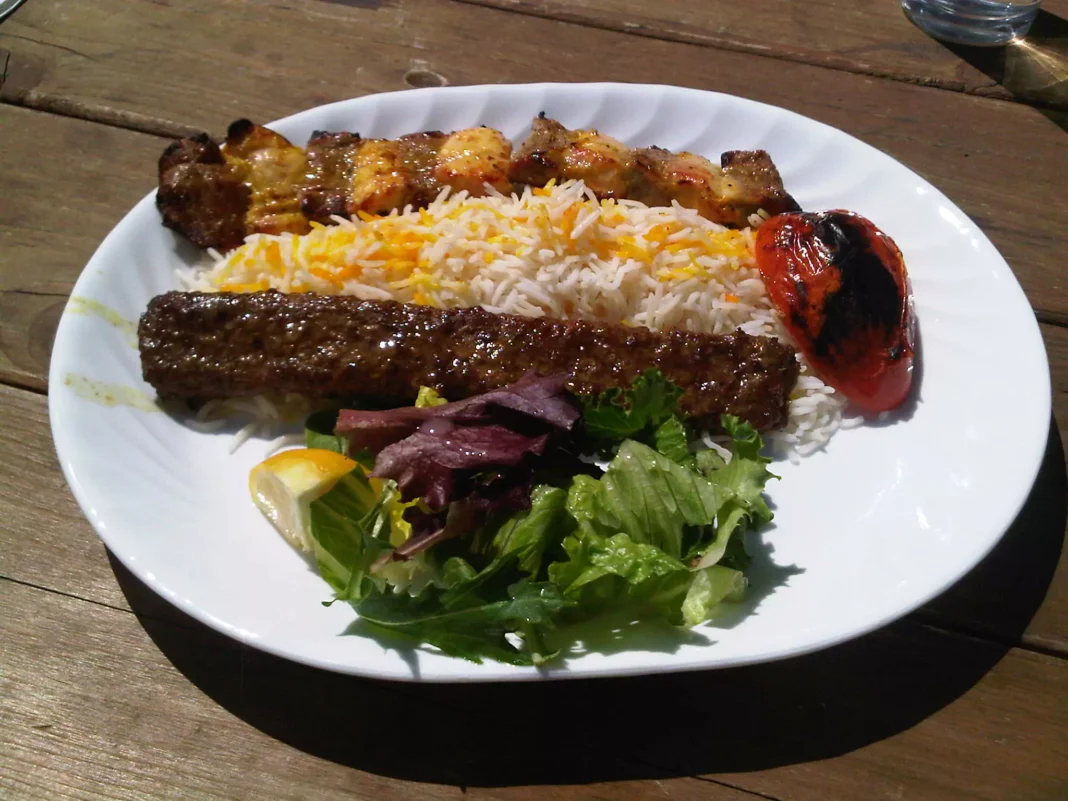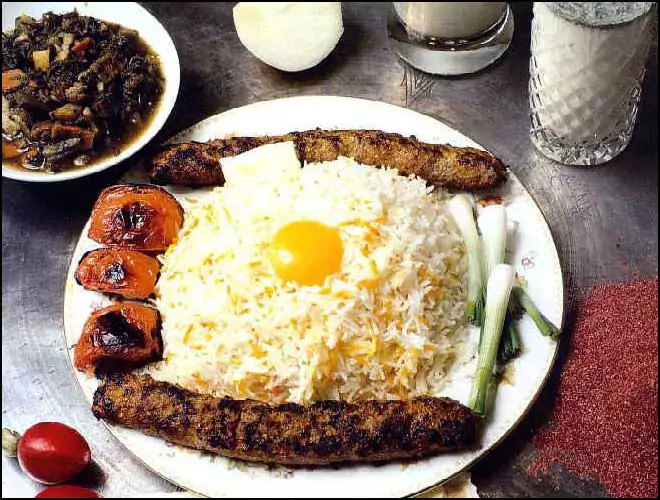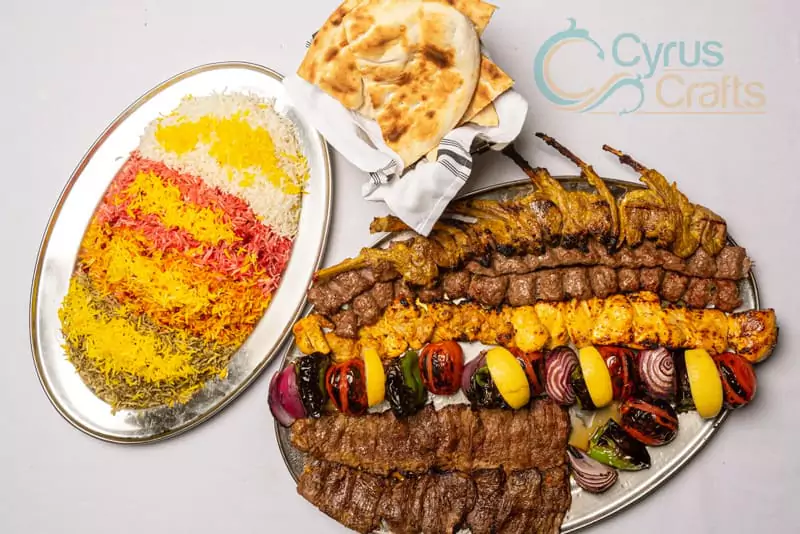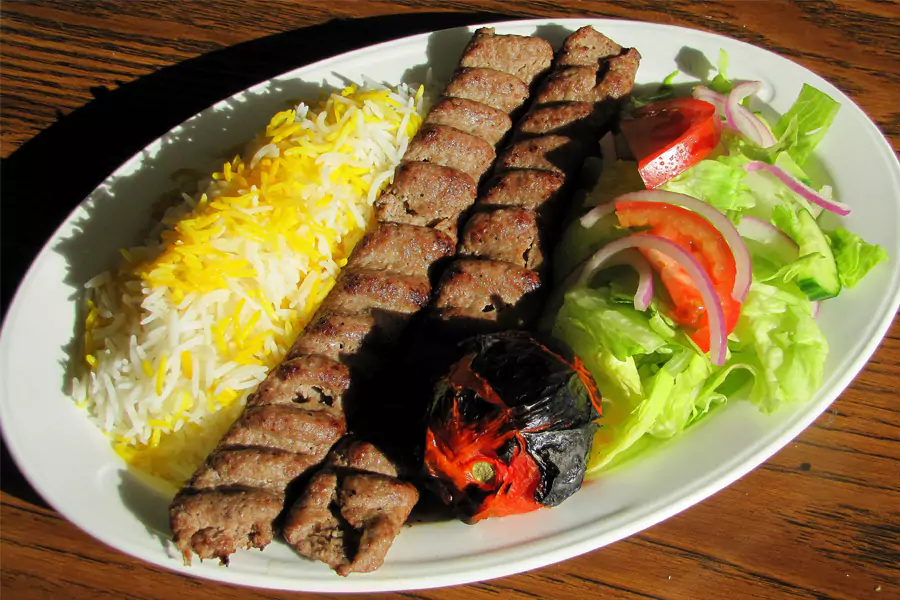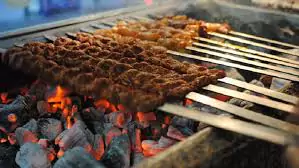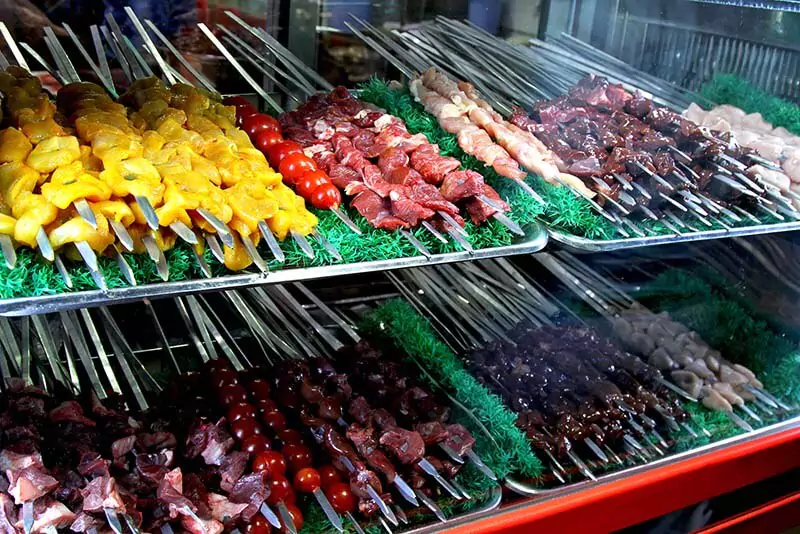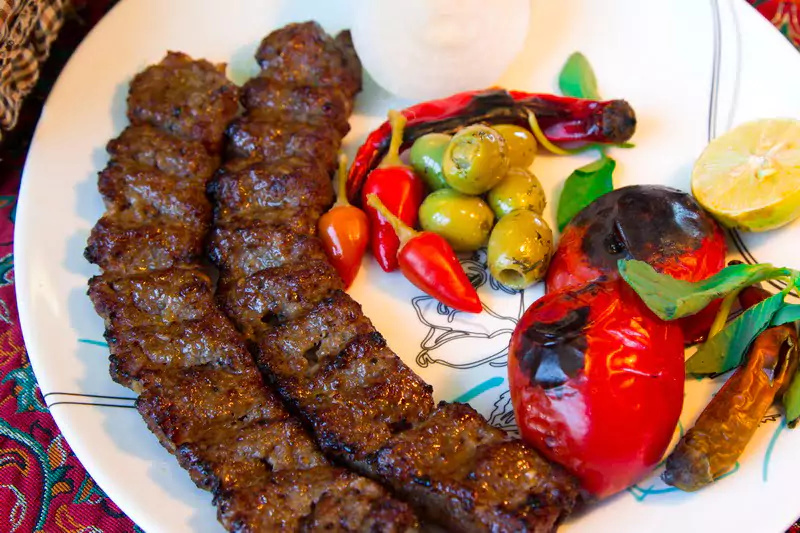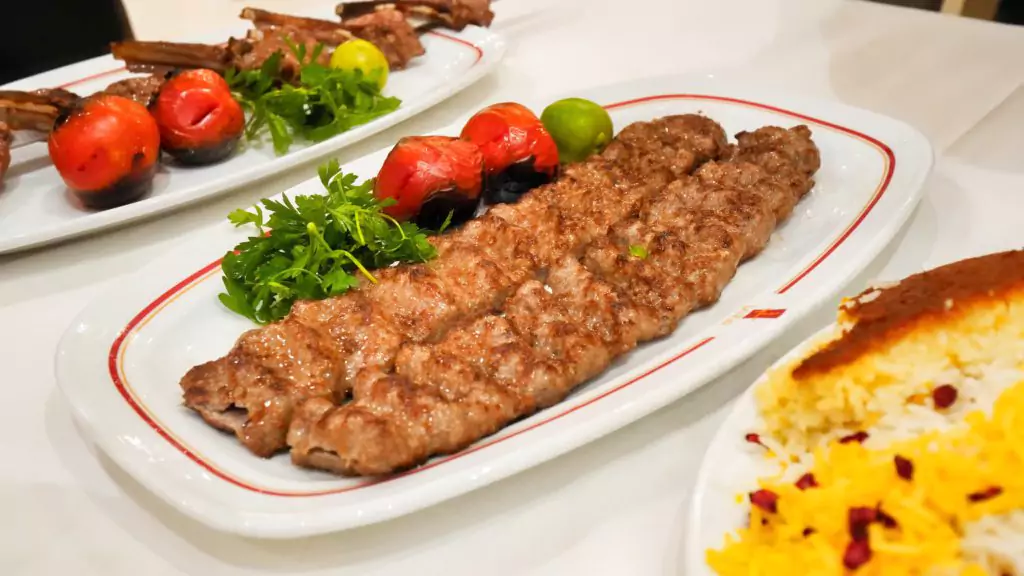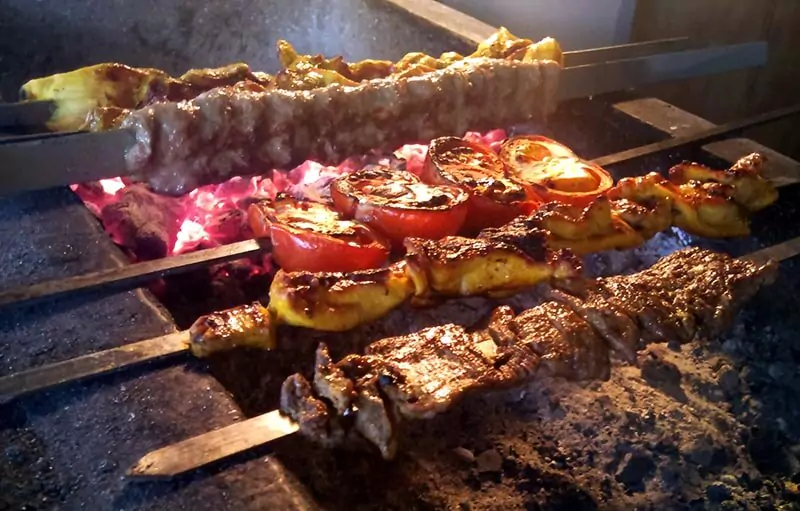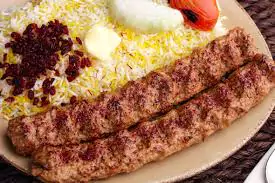Introduction: A Taste of Persia
Chelo Kebab is more than just a dish in Iran; it’s a culinary symphony that embodies the country’s rich history, culture, and passion for food. This iconic meal, featuring succulent grilled meat (often lamb), fluffy saffron-infused rice, and juicy grilled tomatoes, is a must-try for any traveler seeking an authentic taste of Persia.
This comprehensive guide will take you on a delectable journey through the world of Chelo Kebab in Iran. From understanding its origins and regional variations to uncovering the best restaurants and mastering the art of preparing it yourself, we’ll equip you with everything you need to know to savor this quintessential Iranian dish.
The History and Cultural Significance of Chelo Kebab
Origins and Evolution
While the exact origins of Chelo Kebab are debated, it’s believed to have roots in the Caucasus region, brought to Iran during the Qajar dynasty in the 19th century. Over time, it evolved into the beloved national dish we know today, symbolizing Iranian hospitality and culinary artistry.
Chelo Kebab and Iranian Identity
Chelo Kebab holds a special place in Iranian culture, often served during gatherings, celebrations, and family meals. It represents more than just sustenance; it’s a symbol of national pride and a testament to Iran’s rich culinary heritage.
Deconstructing the Dish: Anatomy of a Perfect Chelo Kebab
The Meat: Lamb, Chicken, and Beyond
Traditionally, Chelo Kebab features tender lamb skewers grilled to perfection. However, variations with chicken, beef, and even fish are also popular. The meat is often marinated in a blend of spices and herbs, adding depth and complexity to the flavor.
The Rice: Saffron-Infused Perfection
The “Chelo” in Chelo Kebab refers to the fluffy, white rice that forms the base of the dish. It’s typically steamed and infused with saffron, giving it a delicate aroma and a beautiful golden hue.
The Accompaniments: Tomatoes, Onions, and More
Grilled tomatoes are the classic accompaniment to Chelo Kebab, adding a touch of sweetness and acidity. Other popular additions include raw onions, fresh herbs, and a dollop of creamy yogurt.
Regional Variations: Exploring the Diverse Flavors of Chelo Kebab
Tehran: The Heart of Chelo Kebab
In Tehran, the capital city, you’ll find countless restaurants specializing in Chelo Kebab. Each establishment has its own unique twist on the dish, but the emphasis is always on high-quality ingredients and expert grilling techniques.
Isfahan: A Touch of Elegance
Isfahan, known for its refined cuisine, offers a more delicate version of Chelo Kebab. The meat is often marinated in yogurt and saffron, resulting in a tender and flavorful kebab.
Tabriz: Where it All Began
Tabriz, believed to be the birthplace of Chelo Kebab in Iran, boasts a more traditional approach. The kebabs are typically grilled over charcoal, giving them a smoky flavor, and served with simple accompaniments like grilled tomatoes and raw onions.
Finding the Best Chelo Kebab in Iran: A Guide to Top Restaurants
1. Shandiz Mashhad
- Address: Vakilabad Blvd., Mashhad
- Opening Hours: 12:00 PM – 11:30 PM
- Contact Information: +98 51 3885 0000
- Known for: Juicy Barg (filet mignon) and koobideh with traditional saffron rice.
- Must-try: Barg Kebab with tahdig (crispy rice).
- Why visit: Famous for its premium quality meat and generous portions, Shandiz is an iconic destination for Persian kebabs with an upscale ambiance.
2. Nayeb Restaurant
- Address: 28th St., Sa’adat Abad, Tehran
- Opening Hours: 12:00 PM – 10:00 PM
- Contact Information: +98 21 2235 3355
- Known for: Inventing the modern-style Chelo Kebab restaurant.
- Must-try: Chelo Kebab Soltani (a mix of Barg and koobideh).
- Why visit: One of the oldest and most respected names in Iranian cuisine, known for consistency and quality.
3. Alighapoo Restaurant
- Address: Valiasr St., Tehran
- Opening Hours: 12:00 PM – 11:00 PM
- Contact Information: +98 21 2204 8080
- Known for: Authentic, traditionally prepared Chelo Kebab.
- Must-try: Chenjeh Kebab (grilled lamb chunks).
- Why visit: A combination of classic Persian decor and expertly crafted dishes makes this a must-visit.
4. Dadgaran
- Address: Chaharbagh St., Isfahan
- Opening Hours: 12:00 PM – 11:00 PM
- Contact Information: +98 31 3222 7777
- Known for: Regional spin on koobideh with aromatic saffron rice.
- Must-try: Koobideh Kebab with zereshk (barberry) rice.
- Why visit: Offers a cultural experience with flavors unique to Isfahan.
5. Haj Ali Darvish
- Address: Bazaar District, Shiraz
- Opening Hours: 11:00 AM – 9:00 PM
- Contact Information: +98 71 3224 0011
- Known for: Traditional koobideh in a cozy, historic setting.
- Must-try: Koobideh with fresh, fluffy bread.
- Why visit: Perfect for a casual dining experience while exploring the Shiraz Bazaar.
6. Safir Garden Restaurant
- Address: Sahel Blvd., Kish Island
- Opening Hours: 1:00 PM – 11:30 PM
- Contact Information: +98 76 4445 5566
- Known for: Grilled seafood alongside Chelo Kebab.
- Must-try: Mixed grill platter including koobideh and lamb chops.
- Why visit: A beautiful garden setting that’s ideal for families and tourists.
7. Firoozeh Restaurant
- Address: Darakeh, Tehran
- Opening Hours: 12:00 PM – 11:00 PM
- Contact Information: +98 21 2219 1111
- Known for: Mountain-side dining with fresh air and excellent kebabs.
- Must-try: Boneless Jujeh Kebab (chicken kebab).
- Why visit: Located in a scenic area, making it a perfect escape from the bustling city.
8. Mozaffariyeh Restaurant
- Address: Shah Abbasi Caravanserai, Yazd
- Opening Hours: 11:00 AM – 10:00 PM
- Contact Information: +98 35 3622 3444
- Known for: Kebabs served with Yazdi-style sweet rice.
- Must-try: Saffron-infused koobideh with a local twist.
- Why visit: A historical setting that enhances your dining experience.
9. Darvishi Royal Restaurant
- Address: Imam Reza Blvd., Mashhad
- Opening Hours: 12:00 PM – 11:00 PM
- Contact Information: +98 51 3854 7777
- Known for: Lavish koobideh paired with premium saffron rice.
- Must-try: Chelo Kebab Shishlik.
- Why visit: Opulent ambiance and service befitting a royal feast.
10. Sangi Restaurant
- Address: Tabriz Old Bazaar, Tabriz
- Opening Hours: 11:00 AM – 9:00 PM
- Contact Information: +98 41 3544 8888
- Known for: Grilled lamb koobideh with lavash bread.
- Must-try: Chenjeh Kebab with fresh yogurt.
- Why visit: Combines Tabrizi hospitality with a focus on quality.
11. Darya Restaurant
- Address: Caspian Blvd., Ramsar
- Opening Hours: 12:00 PM – 11:00 PM
- Contact Information: +98 11 5522 7788
- Known for: Sea-view dining with koobideh as the main attraction.
- Must-try: Mixed platter with koobideh and chicken kebabs.
- Why visit: The serene setting by the Caspian Sea adds to the experience.
12. Yeganeh Traditional Restaurant
Why visit: An excellent spot for tourists exploring Esfahan’s cultural heritage.
Address: Imam Square, Esfahan
Opening Hours: 12:00 PM – 11:00 PM
Contact Information: +98 31 3224 5566
Known for: A focus on local flavors and traditional ambiance.
Must-try: Soltani Kebab with saffron-infused rice.
Beyond the Restaurants: Experiencing Chelo Kebab Like a Local
Home-cooked Chelo Kebab: A Taste of Tradition
To truly immerse yourself in Iranian culture, try Chelo Kebab in a local home. Many families are happy to share their culinary traditions with visitors, offering a glimpse into the heart of Iranian hospitality.
Street Food Stalls: A Quick and Delicious Bite
For a more casual experience, sample Chelo Kebab from street food vendors. These stalls offer a quick and affordable way to enjoy this iconic dish, often with unique regional twists.
Picnics and Outdoor Gatherings: Chelo Kebab in Nature
Iranians love to enjoy Chelo Kebab outdoors, whether it’s a picnic in a park or a gathering in a garden. This adds another layer of enjoyment to the experience, combining delicious food with beautiful scenery.
Mastering the Art: Tips for Preparing Chelo Kebab at Home
Choosing the Right Meat
Opt for tender cuts of lamb or chicken with a good amount of marbling. Marinating the meat for at least a few hours will enhance its flavor and tenderness.
Preparing the Rice
Use high-quality basmati rice and soak it in water for at least 30 minutes before cooking. Infuse the rice with saffron for a fragrant and colorful touch.
Grilling Techniques
Grill the kebabs over medium-high heat, turning them regularly to ensure even cooking. Avoid overcooking the meat, as it can become dry and tough.
Serving and Presentation
Arrange the Chelo Kebab on a platter with the rice mounded in the center and the kebabs placed on top. Garnish with grilled tomatoes, raw onions, and fresh herbs.
Chelo Kebab and Dietary Considerations
Vegetarian Options
While Chelo Kebab traditionally features meat, vegetarian versions are also available. These often include grilled vegetables like eggplant, zucchini, and peppers, offering a delicious and satisfying alternative.
Gluten-Free Adaptations
Chelo Kebab is naturally gluten-free, as it primarily consists of meat and rice. However, be sure to check with restaurants or vendors about any potential cross-contamination if you have celiac disease or gluten sensitivity.
Useful Tips for Chelo Kebab Enthusiasts
- Try different regional variations: Each region in Iran has its own unique take on Chelo Kebab, so be adventurous and explore the diverse flavors.
- Don’t be afraid to experiment: Try different types of meat, marinades, and accompaniments to create your own personalized Chelo Kebab experience.
- Learn some basic Farsi phrases: Knowing a few phrases like “merci” (thank you) and “kheyli khoshmazeh” (very delicious) will enhance your interactions with locals.
- Respect cultural customs: When dining in Iran, be mindful of local customs, such as using your right hand for eating and avoiding excessive waste.
- Embrace the communal dining experience: Chelo Kebab is often shared amongst friends and family, so relax and enjoy the social atmosphere.
Chelo Kebab: More Than Just a Meal
Chelo Kebab is more than just a dish; it’s a cultural experience that reflects the warmth, hospitality, and culinary passion of the Iranian people. By savoring this iconic meal, you’ll gain a deeper appreciation for Iran’s rich heritage and connect with its vibrant culture on a truly delicious level.
The Cultural Significance of Chelo Kebab in Iran
Chelo Kebab, the unofficial national dish of Iran, embodies the heart and soul of Persian cuisine. Its roots date back to the Qajar Dynasty (1789–1925), where it was served as a royal delicacy. Today, it’s a staple of everyday life and festive occasions, showcasing Iran’s culinary artistry and cultural richness. Here are some fascinating stories and insights into its significance:
The Royal Origins: A Dish Fit for Kings
In the 19th century, Chelo Kebab became synonymous with Persian court feasts. Historical accounts reveal that chefs in the Qajar court experimented with marination techniques using yogurt, saffron, and onions to tenderize lamb for grilling. The dish quickly gained prominence, evolving from a royal treat to a national treasure.
Regional Flavors and Variations
Each region in Iran brings its unique twist to Chelo Kebab:
- Tabriz: Known for tender koobideh, often paired with fresh herbs and lavash bread.
- Mashhad: Saffron plays a central role, enhancing both the rice and the kebab’s aroma.
- Shiraz: Emphasizes tangy marinades using pomegranate molasses.
- Yazd: Adds a sweet-and-savory touch with spiced rice accompaniments.
Case Study: The Role of Chelo Kebab in Celebrations
A vivid example of Chelo Kebab’s cultural prominence can be seen during Nowruz (Persian New Year). Families gather around beautifully laid tables, and the meal often centers on a perfectly grilled Soltani kebab. The act of sharing Chelo Kebab strengthens familial bonds, symbolizing prosperity and unity.
Modern Innovations: Fusions and Fine Dining
While the traditional recipe remains untouched in many households, contemporary Iranian chefs have started introducing fusion variations. For instance, in Tehran’s upscale restaurants, you may find wagyu koobideh or saffron-infused chicken kebabs served alongside truffle rice. These adaptations demonstrate how Iranian cuisine continues to evolve while preserving its heritage.
Why Chelo Kebab Matters
Chelo Kebab is more than just a meal—it’s a cultural institution. Its preparation reflects meticulous attention to detail, while its consumption represents hospitality, celebration, and unity. Adding visuals to this narrative can create an engaging, educational guide that captures both the dish’s history and its enduring popularity.


